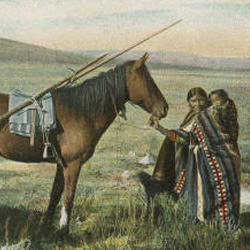History of the Bow and Elbow Rivers
The Elbow and Bow Rivers are ancient water courses dating back to pre-glacial times, 2.5 million years ago.
The Bow and Elbow Rivers as they exist today date from the last retreat of the glaciers and the beginning of the Holocene period ten thousand years ago. The surviving remnants of these glaciers, occupying the upper reaches of valleys in the Rocky Mountains, constitute the headwaters of the Elbow and Bow Rivers.
The flow of water in the Elbow River is subject to fluctuations with a significant spike in the spring determined by the depth of the snow pack, rainfall and the timing of the season change. The annual runoff was originally referred to as a freshet (from the French word freschete or frais meaning fresh). This runoff produced periodic spring floods and regularly reduced water quality from the end of May to early July. During this period, the water carries a greater quantity of suspended solids that give it a cloudy appearance, referred to as turbidity. The impact of the Elbow and Bow Rivers on the adjacent land is maximized during these periods of peak flows which occur on a regular basis between late May and early July. Winter floods have also been a feature of Calgary through to the early 1960s. They usually occurred between mid-November and December and were caused by the development of frazzle (also referred to as need) ice. This type of ice is a mixture of needle shaped ice crystals and water at or below zero degrees Celsius which has the appearance of slush. It is found in turbulent water characteristic of the Bow River above Calgary. The frazzle ice would accumulate on the upstream side of obstructions in the river creating temporary dams behind which the water rose high enough to flood the adjacent land.
First Nations
 Calgary Public Library PC-827
Calgary Public Library PC-827The interaction between the fluctuations in river flows and human history began with the First Nations. Being very much aware of these cycles, they developed a trail system located on the plains above the Bow River valley rather than using the river for transportation. These trails had the added advantage of being the shortest distance between two points since the curves in the rivers were avoided. First Nations used the valley for shelter and to obtain fuel and food. They could move when required to avoid high water. Extreme flood events could temporarily prevent their crossing of rivers.
Beginnings of permanent settlement
 Calgary Public Library PC-132
Calgary Public Library PC-132The establishment of Fort Calgary and a Hudson's Company trading post at the confluence of the Bow and Elbow Rivers (as well as a Catholic Mission further upstream on the Elbow) in 1875 began the permanent occupation of the floodplain in Calgary. Prior to the arrival of the Canadian Pacific Railway in 1883, Calgary stretched from the confluence along the Elbow River to the Catholic Mission. Fort Calgary, the Catholic Mission, the Hudson's Bay Company post and the assorted farm buildings located along the Elbow River were, however, easily replaced in the event of a flood. Only one bridge and no utility systems had been built during this period.
Arrival of the Canadian Pacific Railway (CPR)
The Canadian Pacific Railway was completed through the Bow River valley between August and December of 1883. The arrival of the CPR ensured the development of a major urban community on the flood plain at the confluence of the Bow and Elbow Rivers. Beginning in December 1883, the CPR began to survey and sell the land in section 15 while the Dominion Government did the same with land to the west in section 16. Other floodplain communities developed, particularly in the period after 1900 resulting in floods becoming a major feature in Calgary's history.